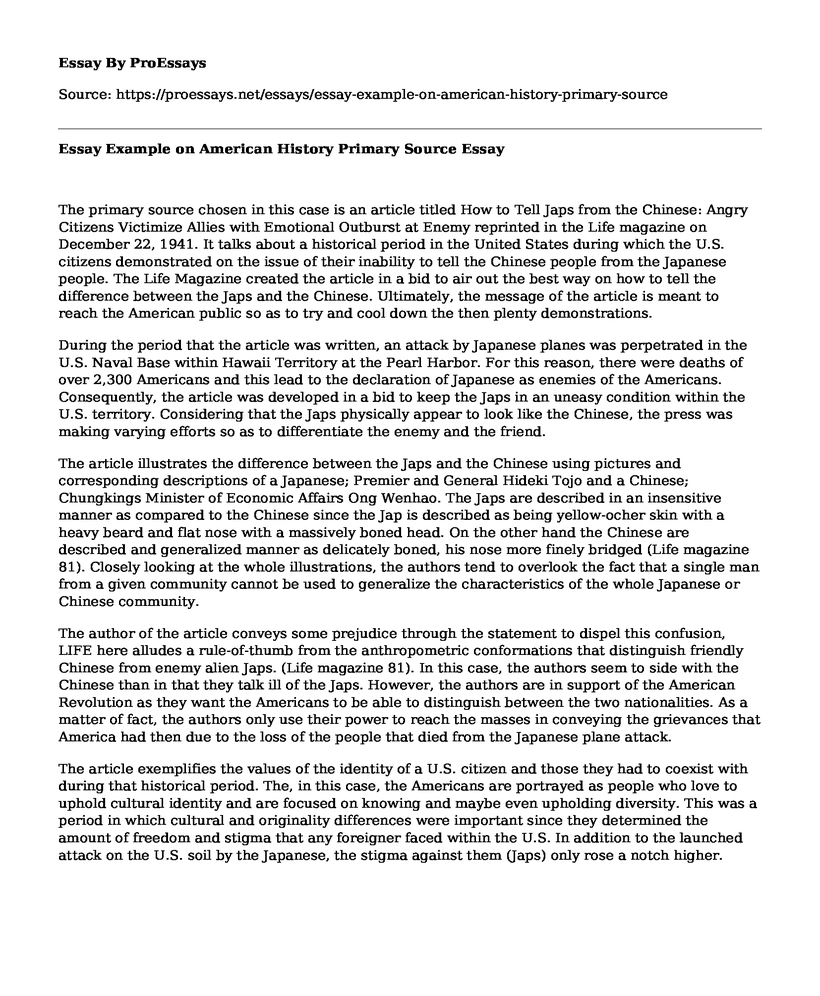The primary source chosen in this case is an article titled How to Tell Japs from the Chinese: Angry Citizens Victimize Allies with Emotional Outburst at Enemy reprinted in the Life magazine on December 22, 1941. It talks about a historical period in the United States during which the U.S. citizens demonstrated on the issue of their inability to tell the Chinese people from the Japanese people. The Life Magazine created the article in a bid to air out the best way on how to tell the difference between the Japs and the Chinese. Ultimately, the message of the article is meant to reach the American public so as to try and cool down the then plenty demonstrations.
During the period that the article was written, an attack by Japanese planes was perpetrated in the U.S. Naval Base within Hawaii Territory at the Pearl Harbor. For this reason, there were deaths of over 2,300 Americans and this lead to the declaration of Japanese as enemies of the Americans. Consequently, the article was developed in a bid to keep the Japs in an uneasy condition within the U.S. territory. Considering that the Japs physically appear to look like the Chinese, the press was making varying efforts so as to differentiate the enemy and the friend.
The article illustrates the difference between the Japs and the Chinese using pictures and corresponding descriptions of a Japanese; Premier and General Hideki Tojo and a Chinese; Chungkings Minister of Economic Affairs Ong Wenhao. The Japs are described in an insensitive manner as compared to the Chinese since the Jap is described as being yellow-ocher skin with a heavy beard and flat nose with a massively boned head. On the other hand the Chinese are described and generalized manner as delicately boned, his nose more finely bridged (Life magazine 81). Closely looking at the whole illustrations, the authors tend to overlook the fact that a single man from a given community cannot be used to generalize the characteristics of the whole Japanese or Chinese community.
The author of the article conveys some prejudice through the statement to dispel this confusion, LIFE here alludes a rule-of-thumb from the anthropometric conformations that distinguish friendly Chinese from enemy alien Japs. (Life magazine 81). In this case, the authors seem to side with the Chinese than in that they talk ill of the Japs. However, the authors are in support of the American Revolution as they want the Americans to be able to distinguish between the two nationalities. As a matter of fact, the authors only use their power to reach the masses in conveying the grievances that America had then due to the loss of the people that died from the Japanese plane attack.
The article exemplifies the values of the identity of a U.S. citizen and those they had to coexist with during that historical period. The, in this case, the Americans are portrayed as people who love to uphold cultural identity and are focused on knowing and maybe even upholding diversity. This was a period in which cultural and originality differences were important since they determined the amount of freedom and stigma that any foreigner faced within the U.S. In addition to the launched attack on the U.S. soil by the Japanese, the stigma against them (Japs) only rose a notch higher.
Cite this page
Essay Example on American History Primary Source. (2021, Jun 17). Retrieved from https://proessays.net/essays/essay-example-on-american-history-primary-source
If you are the original author of this essay and no longer wish to have it published on the ProEssays website, please click below to request its removal:
- Book or Article Review Worksheet Example
- Edward Henry Weston Biography
- George O'Leary's Dismissal Paper Example
- Annotated Bibliography on Zimbabwe (Rhodesia)
- Essay Example on Spartan Hegemony: Unsuccessful & Athenian Alliance/League Difference
- Essay Sample on The Abolitionist Movement: Ending Slavery and Fuelling Debate
- US Involvement in Vietnam War: Stopping Communism's Global Spread - Free Paper Sample







